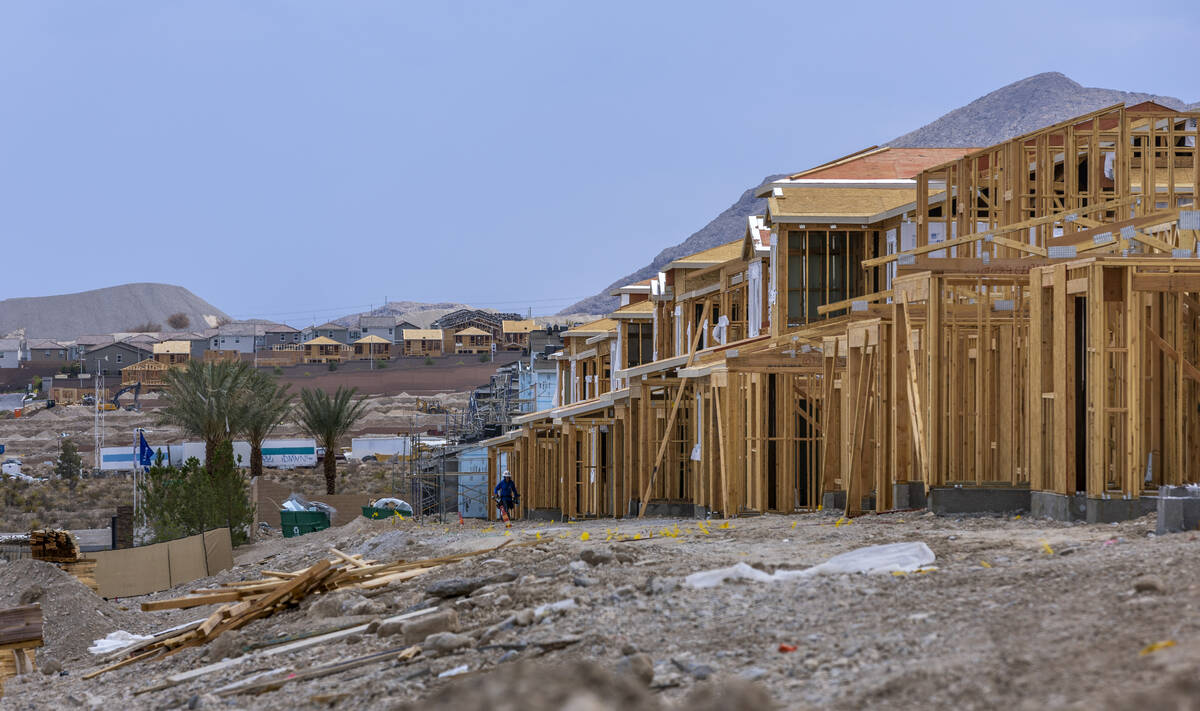The Las Vegas new-home market is expected to see 30 percent fewer net sales for this year compared to 2021 when the final numbers are crunched by the end of January, but builders hope population gains will boost the marketplace even as mortgage rates remain elevated for now.
A strong start to 2022 was halted by rising interest rates in the spring when the Federal Reserve moved to fight inflation by dampening consumer demand.
There were 12,902 net sales (sales minus cancellations) in 2021, according to Las Vegas-based Home Builders Research. That was the most since the housing downturn of the Great Recession, and there was optimism that 2022 would be greater than that until the Fed acted.
Home Builders Research President Andrew Smith predicted the net sales decline could be about 30 percent, which would put the final numbers just over 9,000. There were 11,059 net sales in 2020 as sales surged after an initial slowdown at the start of the pandemic.
When final year-end closing numbers are calculated in January, Smith projects the 2022 numbers will decline 2 percent to 3 percent from 2021 when there were 12,140. There were 10,506 closings in 2020, and Smith said they will be up 15 percent from that mark.
“I think everybody knows that things have slowed down pretty substantially from where they were the past couple of years,” Smith said in an interview. “It’s important to keep in mind that the way things were going then was abnormal on the other side of the spectrum.”
Smith said how quickly and strongly the Federal Reserve adjusted rates caught many people by surprise. If rates didn’t go up as much as they had, a lot more new homes would still be sold, he added.
The 30-year fixed mortgage rate hovered around 3 percent to start 2022 and surpassed 7 percent in November. They’ve come down to 6.5 percent by late December.
The latest interest rate increase casts another cloud over the already murky outlook going into the new year, Smith said in his newsletter sent to the building industry this week.
“The National Association of Home Builders is stating that demand for new housing will be tough in the first half of 2023 and that rates will stay elevated until 2024,” Smith said. “That being said, Redfin is reporting that Las Vegas still remains No. 2 in the country in terms of net inflow.”
The median price for new single-family homes sold in November was $512,923, some 9.16 percent higher than November 2021 but down from $522,961 in October. That price were 12.9 percent higher than October 2021.
Smith said he expects prices to decrease, but it won’t be a major drop and “more of a minor correction” and balance out products that were overpriced over the last couple of years.
“Most of the people in high positions for the local builders were all around in the mid-2000s (when the housing collapse happened),” Smith said. “They are not flying blind when it comes to a recession, and they know what happened back then and don’t want to see it happen again.”
Smith said they’re doing a good job of avoiding “one-upmanship” as far as lowering prices too much too quickly. Builders were more focused on keeping up sales velocities in the 2000s and were quick to slash prices to do so, he said.
“Even though the rates have been a little bit of a surprise, we all knew it was going to happen,” Smith said. “We didn’t think it would be this drastic this quickly, but there was already an expectation that by the end of this year things were going to slow down.”
Builders understand the cycle is changing and that they will have to accept lower sales rates and how it’s not in their best interest individually and for the industry to slash prices to keep up with the number of sales, Smith said.
“Prices are an understandably hot issue in the market today, as they have been since the grip of the pandemic,” Smith said. “Over the past few months though, the conversation has changed from how high prices have gone to how far and how quickly they are falling.”
Home Builders Research cited five builders who had large drops in base prices in November since peaking in May.
■ Taylor Morrison had a 21 percent decrease from $663,564 to $527,382.
■ Storybook Homes had a 9 percent decline from $466,395 to $423,227.
■ Beazer Homes fell 9 percent from $457,882 to $416,414.
■ Richmond American fell 7 percent to $515,622 to $479,077.
■ KB Home fell 6 percent from $447,857 to $420,677.
“The 21 percent decline in average base asking prices by Taylor Morrison certainly caught our attention,” Smith said in his newsletter. “We thought perhaps they had a significant change in the size of available products over that period but that is actually not the case. The average square footage of available products was, and remains, right around 2,100 square feet. Overall though, we see that local builders have exercised restraint in dropping base asking prices during the second half of the year. They have averaged just a 4 percent decrease from the peak by using incentives and rate buy-downs to entice buyers.”
The housing market’s prices were high in January 2022 so in January 2023 there will be a substantial drop in prices in comparison, Smiths said during an interview.
“By the time we get to the middle and the end of the year, compared to this year, I think it would be 10 percent or so or even less than that,” Smith said. “I think they will be pretty steady in general. If things improve by the middle or end of next year, we might start to see them go up a little bit.”
Smith said all of the other factors affecting affordability in the market are still present. People continue to move to Las Vegas, and the buyer demand is there, he said.
“The thing keeping buyers on the sidelines are the interest rates,” Smith said. “If that improves, all of those other factors are still there, not to mention there’s going to be another inventory situation since they cut production, now. If sales start to pick up again next year, they will struggle to have inventory to fill that. I wouldn’t be all that surprised if prices were going up again by the end of next year.”
Smith said sales numbers for the first quarter of 2023 will be down dramatically from the first quarter of 2022, but that’s because the housing market was “still riding high” during the first quarter of 2022 based on the strength of 2021, he noted.
“I would be surprised if 2023 had a 15 percent or 20 percent decline (in sales),” Smith said. “I think it will be closer to 10 percent.”
If buyers think the market will improve in three months, they are probably wrong. If there is any urgency to move, now would be the time to do it, Smith said.
“What’s going on with new homes right now?” Smith asked. “They are offering incentives. Prices have dropped a little bit. They are buying down (interest) rates. If things change a little bit and they go through the inventory they have right now and have a better situation in terms of sales, those incentives will be gone and rate buy-downs are going to be gone and the inventory is not going to be there.”
Affordability is an issue, but if a buyer has the ability to pull the trigger for a new home, now is a better time to do it than February or March, Smith said.
Homebuilder executives weigh in
Nat Hodgson, CEO of the Southern Nevada Home Builders Association, said while the first quarter of 2022 was great, that skewed the entire year’s performance.
Instead of 1,100 permits a month, builders were taking out 1,400 permits, and then those numbers dropped to 400 to 550 a month for builder members, he said.
The SNHBA represents about 90 percent of the market share, and Hodgson forecasts the year will end with builders taking out about 11,200 permits. They took out 14,200 in 2021, 11,800 in 2020 and 11,000 in 2019.
“(At the start of the year) we were on pace for 17,500, which I didn’t know who was going to build those,” Hodgson said.
Hodgson questions why people are waiting to buy because even with higher interest rates, they can purchase now and refinance their homes in a couple of years.
“We weren’t keeping up with the demand before so what do you think will happen when everybody gets off the sidelines,” Hodgson said. “There’s people that have to buy.”
Hodgson said there’s a standing inventory of homes and those to be completed within 30 days of fewer than 400. That’s not a lot, he added.
That means a lot of the incentives like an interest rate buy down will disappear when January comes, Hodgson said.
Other incentives have been free options if the homes are standing inventory or paying closing costs. Those will disappear, as well, Hodgson said. He added that it’s difficult to predict 2023 but says builders will probably take out between 9,000 and 10,000 permits. That could be the fewest since builders took out 9,400 in 2017, he said.
He also agrees the market is helped because people are still employed and continue to move to Las Vegas.
“We have more than 10,000 a month with in-migration,” Hodgson said. “That’s a game changer. Where are they going to live? If your sales come back in the first quarter, we will beat 2022.
Builders, meanwhile, continue to face issues with the supply chain and getting the materials they need. Because of the slowdown, this should help the supply chain catch up, Hodgson said.
“We’re not in a terrible spot,” Hodgson said. “We are going through a rough time right now, and it will pass and be short. The question is short another 30 days or three months.”
Brian Kunec, outgoing president of the builders’ group board of directors, said Las Vegas isn’t any different than most of the housing markets in the U.S. but has held up stronger. Even though the prices have gone up over the last two years, it’s still more affordable than others by comparison, Kunec said.
“The Fed is trying to cool inflation and increase interest rates, which increases the cost of borrowing money and makes monthly payments a lot less affordable,” Kunec said. “I think we will start coming back sometime in 2023. When mortgage rates go up from 3½ percent or 4 percent to more than 7 percent in six months, that’s a tremendous change. It created a slowdown and correction with price drops and folks not being able to afford the homes.”
Kunec admits there’s a lot of uncertainty out there and recent job cuts in the U.S. have created a lack of buyer confidence.
“Once things stabilize and the Fed stops doing interest rate raises and keeps them where they are at for a while and the stock market stabilizes, business leaders can make more educated decisions. Then we can start seeing positive benefits from that,” Kunec said.
Compared to the housing downturn during the Great Recession, Kunec said there’s a lot of positives in comparison. The last one was created by people who borrowed money who shouldn’t have borrowed money, he said.
“This one has a lot of strong fundamentals behind it,” Kunec said. “Unemployment is still great. There’s little availability of housing supply. It’s artificially created by the Fed, and once they stop tinkering with rates and inflation cools off, I feel when we come out of this, the housing market will be even stronger than the last time. I think you will see even a smaller supply of housing than we had in the last couple of years. We weren’t building what we needed to meet the demand. I think we will come out of this like a springboard. When you have 12 times the demand versus the supply, prices will go up again.”
Kunec said he doesn’t see prices dropping much more than they have in recent months and expects incentives to go away in early 2023 since a lot of builders have sold through their speculative inventory. He said some prices had come down 20 percent and higher in some builder communities.
“This is a good time to buy because I don’t think we will see prices at this level when we get out of it,” Kunec said. “A lot of buyers continue to think prices are going to continue to come down, and I just don’t see it. They have come down a lot already and adjusted to where mortgage rates are. Houses are a lot more affordable even where mortgage rates are. I think once you get through the holidays it’s not a bad idea to go out and buy a home. You can always get an adjustable mortgage product at a good rate. A lot of them give you seven years to refinance. Rates are going to go down at some point.”












